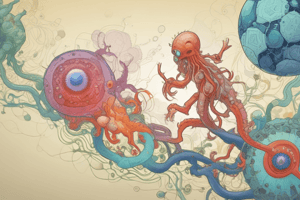Podcast
Questions and Answers
What are the two main types of nucleic acids discussed in the IB Biology syllabus for 2023?
What are the two main types of nucleic acids discussed in the IB Biology syllabus for 2023?
DNA and RNA
What is the main role of enzymes in biological systems?
What is the main role of enzymes in biological systems?
To speed up chemical reactions without being consumed in the process.
What is the role of DNA in living organisms according to the IB Biology syllabus?
What is the role of DNA in living organisms according to the IB Biology syllabus?
DNA contains the instructions used to construct proteins that carry out the workings of cells and living organisms.
Explain the process of cell respiration and its significance in cells.
Explain the process of cell respiration and its significance in cells.
How are proteins formed in living organisms?
How are proteins formed in living organisms?
How does allosteric inhibition affect enzyme activity?
How does allosteric inhibition affect enzyme activity?
What are some of the roles of proteins in living organisms?
What are some of the roles of proteins in living organisms?
In the context of the IB Biology syllabus, what do students learn about nucleic acids?
In the context of the IB Biology syllabus, what do students learn about nucleic acids?
What are the key components of the electron transport chain in cell respiration?
What are the key components of the electron transport chain in cell respiration?
How do mutations affect protein structure and function?
How do mutations affect protein structure and function?
Flashcards
DNA
DNA
The molecule that stores and transmits genetic information.
RNA
RNA
The molecule that helps carry genetic information from DNA to ribosomes for protein synthesis.
Proteins
Proteins
Complex molecules made up of amino acids, linked by peptide bonds.
Enzymes
Enzymes
Signup and view all the flashcards
Cell Respiration
Cell Respiration
Signup and view all the flashcards
Glycolysis
Glycolysis
Signup and view all the flashcards
Citric Acid Cycle
Citric Acid Cycle
Signup and view all the flashcards
Electron Transport Chain
Electron Transport Chain
Signup and view all the flashcards
ATP Synthase
ATP Synthase
Signup and view all the flashcards
Chemiosmosis
Chemiosmosis
Signup and view all the flashcards
Study Notes
IB Biology Syllabus 2023 - Standard Level
The International Baccalaureate (IB) Biology syllabus for the 2023 academic year offers a comprehensive study of biology through a concept-based approach. This standard level course is designed to take students deeply into the world of living organisms, exploring the fundamental concepts that underlie all biological processes. In this article, we'll cover some of the key subtopics within this syllabus, including nucleic acids, proteins, enzymes, cell respiration, and their role in maintaining life.
Nucleic Acids
Nucleic acids—specifically DNA (deoxyribonucleic acid) and RNA (ribonucleic acid)—are the molecules responsible for encoding the genetic instructions used in the growth, functioning, functioning, regulation, reproduction, communication, and adaptation of living beings. DNA contains the instructions used to construct proteins that carry out the workings of cells and living organisms, while RNA can be used to produce proteins based on the information stored in DNA. In the context of the IB Biology syllabus, students will learn about the structure and function of nucleic acids in detail.
Proteins
Proteins are complex molecules made up of amino acids, which are linked together by peptide bonds to form long chains or polymers. These biochemical compounds have numerous roles within living organisms, including structural support, catalysis, transport, regulation, and as components of membranes. The syllabus includes a focus on the synthesis and folding of proteins, their interactions with other molecules, and the effects of mutations.
Enzymes
Enzymes are biological catalysts that speed up chemical reactions without being consumed in the process. They play a crucial role in regulating metabolism and maintaining life. Students studying IB Biology will explore enzyme structure, function, and activity, along with factors affecting enzyme action and control mechanisms such as allosteric inhibition and activation.
Cell Respiration
Cell respiration is the set of metabolic reactions and processes that convert biochemical energy from nutrients into adenosine triphosphate (ATP), the energy currency of cells. This subtopic covers glycolysis, the citric acid cycle, oxidative phosphorylation, electron transport chain, ATP synthase, and chemiosmosis. The syllabus emphasizes the phases of cellular respiration, their interdependence, and how they release stored energy for the cell's use.
These topics cover only the highlights of the extensive IB Biology Standard Level Syllabus for 2023. The course aims not just to impart knowledge but also to develop critical thinking skills, problem-solving abilities, and an understanding of scientific methodologies. As you dive deeper into these subjects, remember that each concept builds upon another, forming a solid foundation for further studies and careers in the life sciences.
Studying That Suits You
Use AI to generate personalized quizzes and flashcards to suit your learning preferences.




